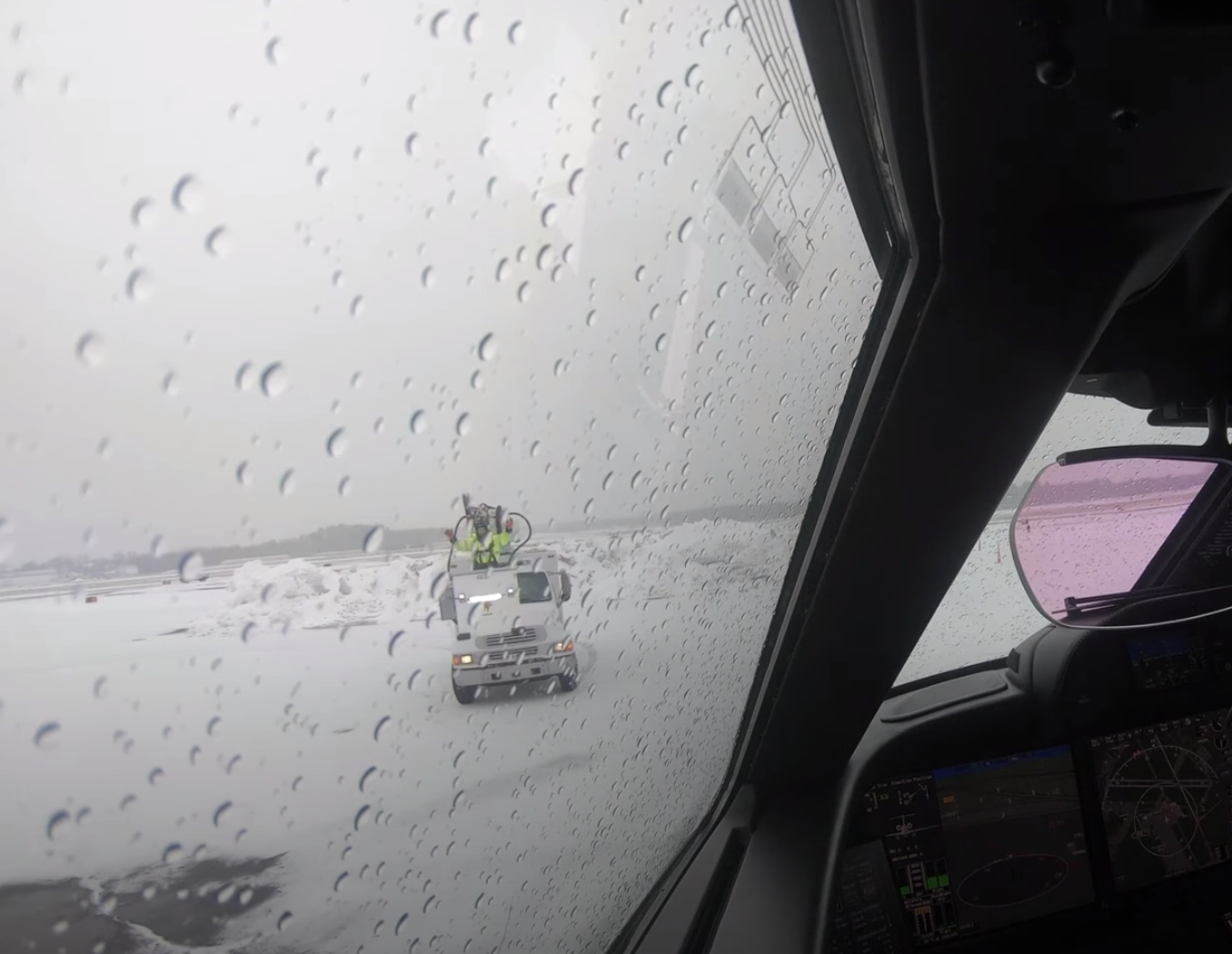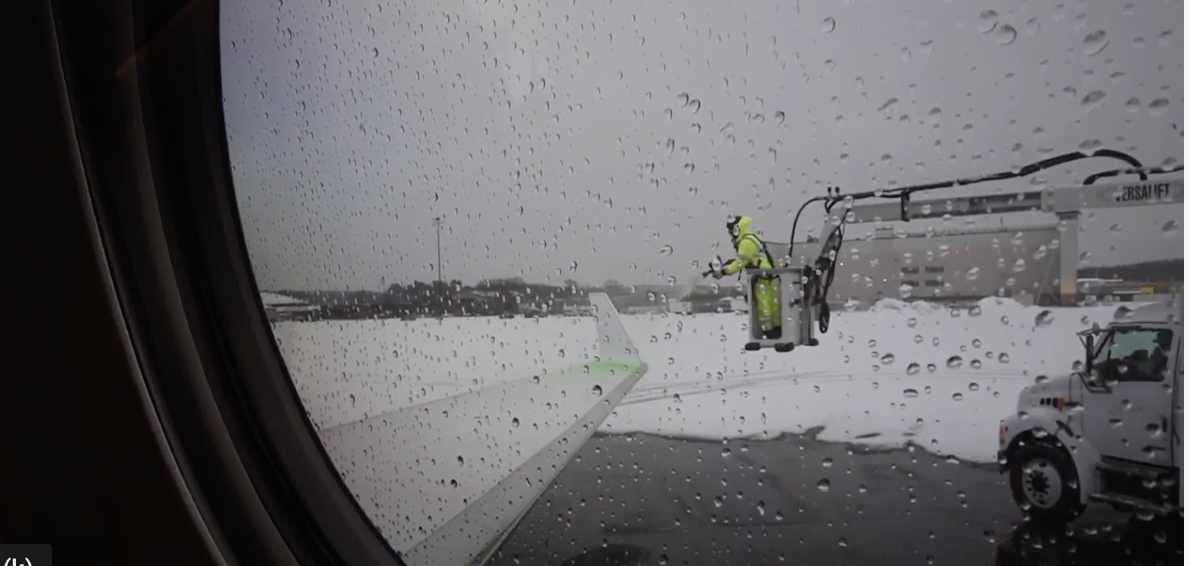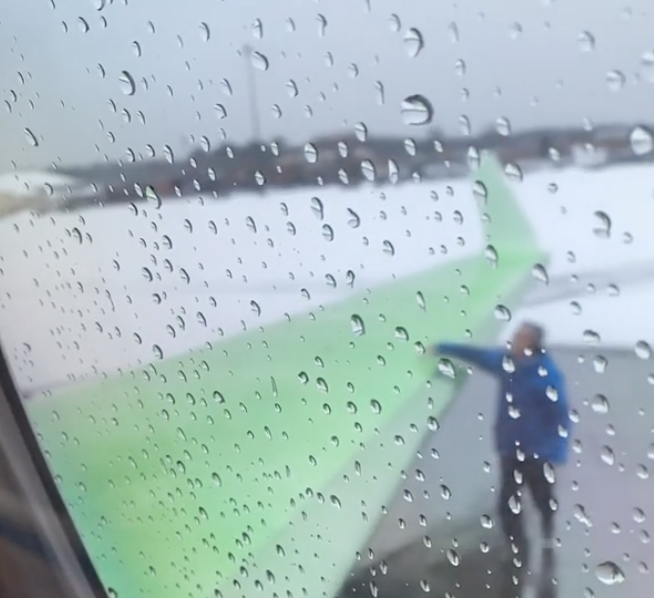
Customize And Follow De-icing Procedures
Photo and video credit: James Albright
Chances are the team operating the de-ice truck have more experience at this than you, but you can’t bet on that. You should know your airplane flight manual procedures for applying de-icing and anti-icing fluid and be able to brief the de-ice team, on the radio if necessary, in short, succinct instructions. For my aircraft, I will have already removed all contamination from my cockpit windows, probes, and landing gear, and will have left the flaps retracted. Having taken those precautions, my brief is short and sweet: “Get the wings and tails and (if necessary) the top of the fuselage. Avoid any direct spray into any intake, probes, or the aircraft undercarriage.” If you can provide a complete briefing on the phone, you will be able to keep it even shorter and sweeter when on the radio.
Chances are the team operating the de-ice truck have more experience at this than you, but you can’t bet on that. You should know your airplane flight manual procedures for applying de-icing and anti-icing fluid and be able to brief the de-ice team, on the radio if necessary, in short, succinct instructions. For my aircraft, I will have already removed all contamination from my cockpit windows, probes, and landing gear, and will have left the flaps retracted. Having taken those precautions, my brief is short and sweet: “Get the wings and tails and (if necessary) the top of the fuselage. Avoid any direct spray into any intake, probes, or the aircraft undercarriage.” If you can provide a complete briefing on the phone, you will be able to keep it even shorter and sweeter when on the radio.

"Get Everything”
Photo credit: AdobeStock/CoolImages
Depending on your aircraft, there may be a specific sequence of events that has to happen prior to the application of any de-ice/anti-ice fluid, as well as another procedure to get the aircraft ready for takeoff with any fluid on the aircraft. Forgetting to turn certain systems off and close certain doors prior to fluid application can introduce harmful fumes into the cabin, or worse. Forgetting to undo what you’ve done can leave your aircraft ill-suited for flight.
Short story: In one of my flight departments, one of our pilots briefed the de-ice team, “get everything.” The other pilot was alarmed because he had never heard that answer before, but he couldn’t remember why that was the wrong answer. One of the properties of Type IV anti-ice fluid is that it is designed to shear from the airplane around 115 knots, and that’s what happened to the fluid on the nose of the aircraft as they raced down the runway, completely obscuring both pilots’ views just at V1 decision speed. They rotated and by the time the wheels were off the ground they regained visibility. Oddly, the pilot in command was known for saying, “I’d rather be lucky than good.” He got his wish.
Depending on your aircraft, there may be a specific sequence of events that has to happen prior to the application of any de-ice/anti-ice fluid, as well as another procedure to get the aircraft ready for takeoff with any fluid on the aircraft. Forgetting to turn certain systems off and close certain doors prior to fluid application can introduce harmful fumes into the cabin, or worse. Forgetting to undo what you’ve done can leave your aircraft ill-suited for flight.
Short story: In one of my flight departments, one of our pilots briefed the de-ice team, “get everything.” The other pilot was alarmed because he had never heard that answer before, but he couldn’t remember why that was the wrong answer. One of the properties of Type IV anti-ice fluid is that it is designed to shear from the airplane around 115 knots, and that’s what happened to the fluid on the nose of the aircraft as they raced down the runway, completely obscuring both pilots’ views just at V1 decision speed. They rotated and by the time the wheels were off the ground they regained visibility. Oddly, the pilot in command was known for saying, “I’d rather be lucky than good.” He got his wish.

Consider Hold Over Time (HOT) Tables
Photo credit: AdobeStock/Murmakova, Video: James Albright
A little-known secret in general aviation is that Hold Over Time (HOT) tables don’t authorize Part 91 crews to skip a pre-takeoff contamination check within HOT times. (14 CFR 91.527 does not make allowances for HOT tables.) In fact, only Part 135 crews with specific training (under 14 CFR 135.227) and ground crews with approval (under 14 CFR 121.629) may do so. Otherwise, Part 135 crews must complete a pre-takeoff contamination check within 5 minutes prior to takeoff when frost, ice, or snow could adhere to the aircraft. Part 91 crews should follow suit. I recommend using the HOT Tables as advisory information, but if the conditions are conducive to further icing, you need to do a tactile inspection of your wings. You might be able to do this from your cabin windows, but in an aircraft with a 50-ft. wingspan, I don’t think your eyes are good enough to do that.
Short story: Many business aviation pilots think taking the time to do a tactile inspection will anger passengers because of the time needed. In my experience, the opposite is true. Years ago I was in the middle aircraft of a line of three Challenger 604s getting de-iced. We completed our de-icing while the first was waiting permission to takeoff. I opened our main entrance door and walked to the left wing tip, touched portions of the wing while inspecting the top and bottom, as well as the tail of the aircraft. I repeated the process on the right wing. The next day the pilot in the first aircraft called me to say I got him in trouble. His passenger wanted to know why the next pilot was more careful than he was. So word to the wise, do your tactile inspection because the pilot in the next airplane might be me!
A little-known secret in general aviation is that Hold Over Time (HOT) tables don’t authorize Part 91 crews to skip a pre-takeoff contamination check within HOT times. (14 CFR 91.527 does not make allowances for HOT tables.) In fact, only Part 135 crews with specific training (under 14 CFR 135.227) and ground crews with approval (under 14 CFR 121.629) may do so. Otherwise, Part 135 crews must complete a pre-takeoff contamination check within 5 minutes prior to takeoff when frost, ice, or snow could adhere to the aircraft. Part 91 crews should follow suit. I recommend using the HOT Tables as advisory information, but if the conditions are conducive to further icing, you need to do a tactile inspection of your wings. You might be able to do this from your cabin windows, but in an aircraft with a 50-ft. wingspan, I don’t think your eyes are good enough to do that.
Short story: Many business aviation pilots think taking the time to do a tactile inspection will anger passengers because of the time needed. In my experience, the opposite is true. Years ago I was in the middle aircraft of a line of three Challenger 604s getting de-iced. We completed our de-icing while the first was waiting permission to takeoff. I opened our main entrance door and walked to the left wing tip, touched portions of the wing while inspecting the top and bottom, as well as the tail of the aircraft. I repeated the process on the right wing. The next day the pilot in the first aircraft called me to say I got him in trouble. His passenger wanted to know why the next pilot was more careful than he was. So word to the wise, do your tactile inspection because the pilot in the next airplane might be me!

Brief Passengers Ahead of Time
Photo and video credit: James Albright
If your passengers are new to winter flying, having a nearby window coated in an orange or green goo can be alarming. Even seasoned passengers may be put off by the sudden delay. Letting them know ahead of time will not only avoid these problems but can serve to increase their confidence when flying in a less than CAVU (Ceiling and Visibility Unlimited) day. Keep in mind your passengers will have a good view of the process that should serve to inspire, not to alarm. You should have confident answers to: “What is that fluid?” “Why is it that color?” “How does it work?”
Short story: After a few years in a new flight department, my passengers became used to the routine and started showing up a little early on those days it looked like we would need to de-ice. They even became used to the post treatment tactile check. We once had a few customers onboard who were not used to the routine. I overheard our passengers give an accurate description of the process and the reason the tactile check was needed. Our customers were impressed. “You guys do everything right,” they said. I think that was meant as much as a compliment for the company officers as it was the flight crew.
If your passengers are new to winter flying, having a nearby window coated in an orange or green goo can be alarming. Even seasoned passengers may be put off by the sudden delay. Letting them know ahead of time will not only avoid these problems but can serve to increase their confidence when flying in a less than CAVU (Ceiling and Visibility Unlimited) day. Keep in mind your passengers will have a good view of the process that should serve to inspire, not to alarm. You should have confident answers to: “What is that fluid?” “Why is it that color?” “How does it work?”
Short story: After a few years in a new flight department, my passengers became used to the routine and started showing up a little early on those days it looked like we would need to de-ice. They even became used to the post treatment tactile check. We once had a few customers onboard who were not used to the routine. I overheard our passengers give an accurate description of the process and the reason the tactile check was needed. Our customers were impressed. “You guys do everything right,” they said. I think that was meant as much as a compliment for the company officers as it was the flight crew.

Towel Dry
I preposition a towel (to wipe my hands after doing the tactile check), put on ear protection, ensure I don't have any lose items on me (lest they be sucked into the engines), and close the cabin door between the passengers and the cockpit before I open the aircraft's main entrance door. You might also consider a separate jacket and shoes for the chore. After I've done the tactile check, I re-board the aircraft, close the main entrance door, and open the door to the cabin. Then I clean off my hands, take off my jacket and hearing protection, and give the passengers a wink. Am I putting on a show for their benefit? I suppose I am. But part of my job is instilling confidence in those who are putting their lives in my hands.
Don’t become complacent about flying in the snow. Consider these steps. This is the second of two parts of this checklist. Here is part one.
